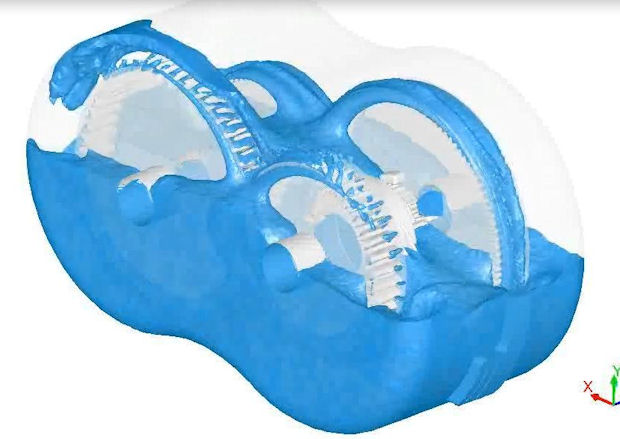Simulating Gear Lubrication: Accurately Predicting Oil Flow Pattern, Temperature and Churning Losses
Latest News
May 28, 2014
 Dear Desktop Engineering Reader:
Dear Desktop Engineering Reader:
One of the necessities of working with gears is to keep them like me: well lubricated. Proper lubrication helps minimize the friction between gears, keeps mechanical losses down, reduces the chance of gear teeth damage and diminishes the odds of over heating and bursting into flame. And let me tell you, I once test-drove a used car in which the dealership’s mechanics forgot to replace the transmission fluid. ’Twas a very short, sad and smoky trip around the block. You need to get lubrication right, and how you can get it right is what the newest technical tip from ANSYS is all about.
The “Simulating Gear Lubrication: Accurately Predicting Oil Flow Pattern, Temperature and Churning Losses” technical resource begins with an 8-minute 40-second video demo. The demo steps you through an ANSYS Fluent CFD (computational fluid dynamics) simulation of oil’s motion inside a gearbox system and how it contributes to gear cooling. There are a lot of neat sights to see in this narrated video. First, there’s a nifty animation of a gearbox with four gears in motion and the oil flowing around the gears and splashing on the cover. The image used in this message is a still from this animation.
You get to see how to build the mesh and simulation, and a cross-section of the meshed gearbox and gears. Most interesting is the shot of the mesh of the regions where the gear teeth make contact. Highlights here include moving and deforming meshes and how you define them as well as setting up the multiphase volume of a fluid model. What’s noteworthy is the ease of setting up the properties of the oil phase.
This tech tip resource comes with three downloadable documents. The technical brief “Simulation of Oil Lubrication and Losses in Gear Transmission System” is, in part, an in-depth complement to the video. In addition to providing deeper technical details on the video demonstration, this 23-page PDF explores the challenges of using CFD to predict flow patterns to ensure proper lubrication and optimum cooling. It also covers predicting losses resulting from such factors as RPM, gear tooth geometry and fluid materials.
The article “Playing It Cool” originally appeared in ANSYS Advantage, the ANSYS user publication. It was written by a gentleman at Toyota’s drivetrain unit engineering design and explains how a Toyota team used CFD simulation to reduce the weight of a drive unit while simultaneously improving its cooling capacity. You’ll recognize some of the images from the video.
Finally, you can download “Cutting Design Costs: How Industry Leaders Benefit From Fast and Reliable CFD.” This 9-page white paper is something of a manifesto that engineers and engineering management need to read and present to their bosses fretting over the costs of product design. It gives real-world examples of companies that have shaved months and even years off development cycles. Many savings are stated in terms of time saved, dollar signs and quality realized. Most of all, this document provides hard dollar and time numbers that’ll be useful during any discussion that formerly ended when you were hit up with questions about return-on-investment.
ANSYS, as you no doubt know, offers a range of fluid dynamics tools applicable to simulating gear system lubrication in complex applications like automobile transmissions or wind turbines. The “Simulating Gear Lubrication: Accurately Predicting Oil Flow Pattern, Temperature and Churning Losses” resource provides a thorough, informative and entertaining overview of these capabilities. Hit today’s Check it Out link to see for yourself.
Thanks, Pal. – Lockwood
Anthony J. Lockwood
Editor at Large, Desktop Engineering
Subscribe to our FREE magazine, FREE email newsletters or both!
Latest News
About the Author
Anthony J. Lockwood is Digital Engineering’s founding editor. He is now retired. Contact him via [email protected].
Follow DE






